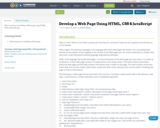
Short exercise on building a Web page using HTML, CSS, and JavaScript.
- Subject:
- Career and Technical Education
- Material Type:
- Activity/Lab
- Date Added:
- 03/28/2017

Short exercise on building a Web page using HTML, CSS, and JavaScript.
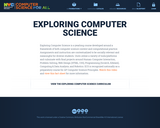
Exploring Computer Science is a yearlong course developed around a framework of both computer science content and computational practice. Assignments and instruction are contextualized to be socially relevant and meaningful for diverse students. Units utilize a variety of tools/platforms and culminate with final projects around Human-Computer Interaction, Problem Solving, Web Design (HTML, CSS), Programming (Scratch, Edware), Computing & Data Analysis, and Robotics. ECS is recognized nationally as a preparatory course for AP Computer Science Principles. Watch this video and view this fact sheet for more information.

An overview of grouping CSS selectors.

A HTML hiperszöveges leírónyelv segítségével weboldalt lehet készíteni. A CSS nyelv leírja hogyan kell kinézzen egy HTML dokumentum. Egyszerűen fogalmazva: a HTML adja a weboldal vázát, míg a CSS "öltözteti" fel az oldalt.

En snabb introduktion till HTML & CSS där man får stöta på hur en enkel html-sida kan se ut samt hur css kan användas för att ändra utseendet. Till sist kommer även förslag på hur man kan gå vidare för att lära sig mera om dessa två språk.
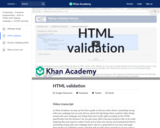
Learn how to validate your webpages with the W3C validator service.
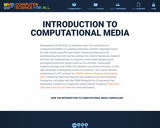
Developed by the NYCDOE CS education team, the Introduction to Computational Media is a yearlong (108 hours) creative computing course for high schools using the open source Javascript library p5.js. By understanding how code can be a medium for creative expression, students will learn the fundamentals of computer science while designing and prototyping interactive projects that run on a browser. Additionally, students will learn how HTML/CSS elements can interact with p5.js to fully take advantage of developing content for a browser. This course has been implemented in NYC schools via CS4All’s Software Engineering Program (SEP), revised by classroom teachers with guidance from the Processing Foundation, and aligns with the CS4All Blueprint for CS education that emphasizes a hands-on CS approach called creative computing. Watch this video and view this fact sheet for more information.

This is an introductory level lesson for the history of the internet and HTML.
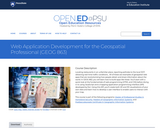
Locating restaurants in an unfamiliar place, reporting potholes to the local DOT, obtaining real-time traffic conditions... All of these are examples of geospatial web apps that are revolutionizing how people obtain and share information about the world. In GEOG 863, you will learn how to build apps like these. You'll start with a quick look at the fundamentals of web programming (HTML and CSS) before diving in to using JavaScript and a mapping application programming interface (API) developed by Esri. Using this API, you'll create both 2D and 3D visualizations of your own data and learn how to develop a user interface to enable users to interact with your map.
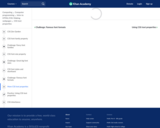
An overview of other CSS text properties.

This book is designed to be used as a class text but should be easily accessible to programmers interested in Web Programming. It should even be accessible to an advanced hobbyist.
The original goal behind this text was to help students doing research with me in Web based mapping applications, generally using Open Layers. The idea was to provide persistent storage using REST and simple http request from JavaScript to store the data on a server.

This course on software engineering covers design and implementation of medium-scale software systems, using web applications as a platform. In the course, students learn the fundamentals of structuring a web application and writing modular code, with an emphasis on conceptual design to achieve clarity, simplicity, and modularity. Topics also include functional programming, relational databases, and security.
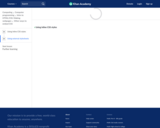
Linking an HTML document to an external stylesheet.
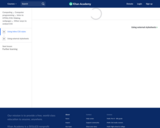
Embedding CSS into a webpage's HTML.
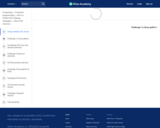
Using multiple classes in CSS to assign attributes.
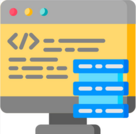
This resource contains the 7 units that are inside of quarter 1 of my Web Development I course at Mountain Heights Academy. This course was written to align Utah's Web Development I Standards (quarters 3 and 4 have not been written yet). Each unit provided takes up about a week. At the end of each unit, I assess my students with an assignment (provided) and quiz (not provided). At the end of the quarter, I assess my students with a midterm exam (not provided). In the first week of my course, I go over my syllabus and other class procedures.
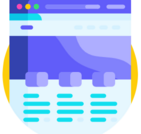
This resource contains the 10 units that are inside of my quarter 2 of my Web Development I course at Mountain Heights Academy. This course was written to align Utah's Web Development I Standards (quarters 3 and 4 have not been written yet). Each unit provided takes up about a week. At the end of each unit, I assess my students with an assignment (provided) and quiz (not provided). At the end of the quarter, I assess my students with either a final exam (not provided) or a project (provided).
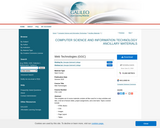
This complete set of course materials contains all files used for in-class activities and labs, a full set of lecture slides, project assignments, and a test bank. Topics covered include:
HTML Basics
CSS
Images
Page Layout
Tables
Forms
Multimedia
JavaScript
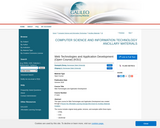
This open course for Web Technologies and Application Development was created through a Round Ten Affordable Learning Georgia Mini-Grant for Ancillary Materials Creation.
The course includes original study guides, lectures, and examples within these topics:
HTML
CSS
JavaScript
Dynamic HTML
HTML Forms
PHP
User Experience
Web App Security
Web 2.0
Mobile Web
The website for the course also features student websites created during the KSU course with Dr. Zheng.
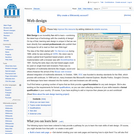
Collection of lots of learning activities, such as CSS Challenges, Javascript Challenges and others which can be used in a group environment or on your own.